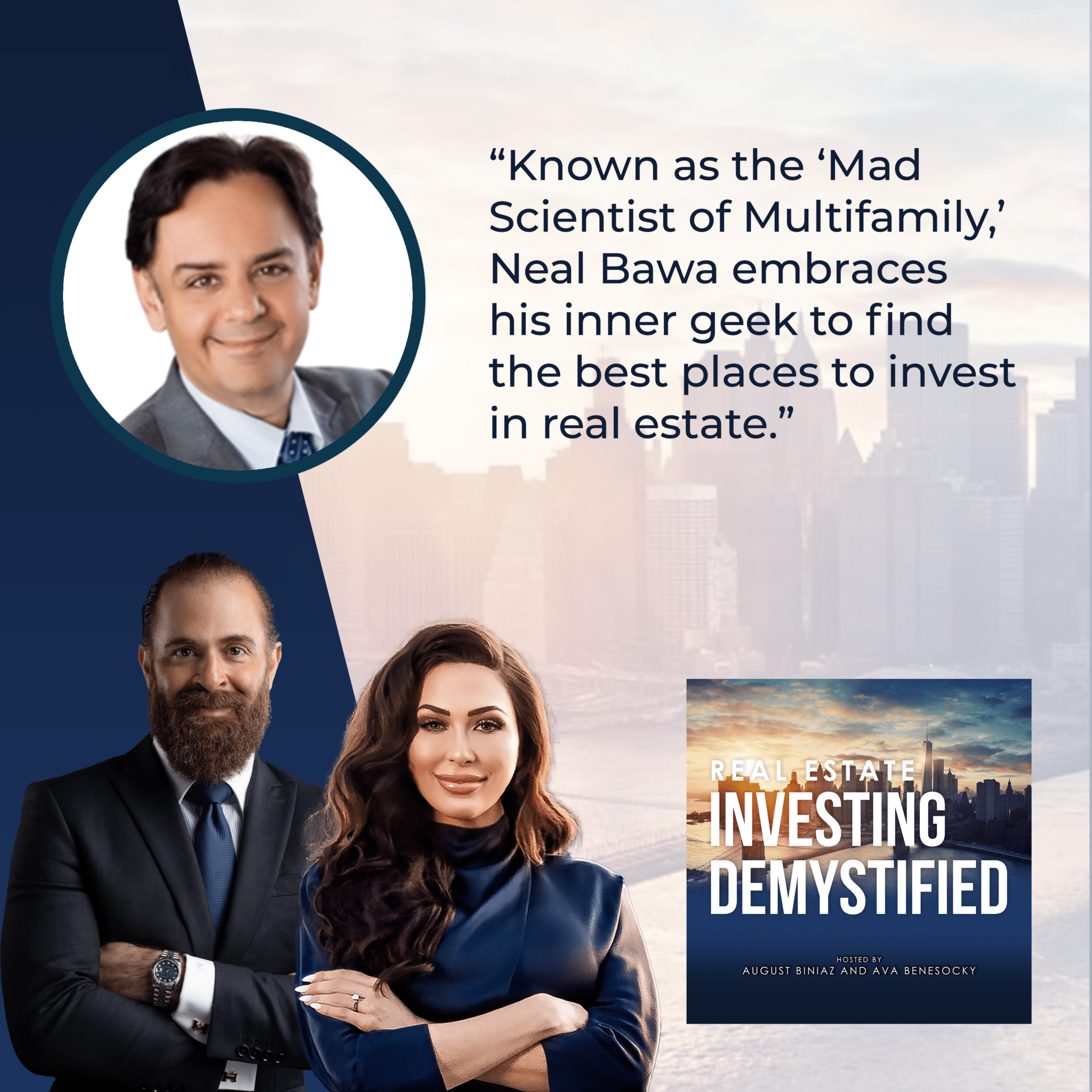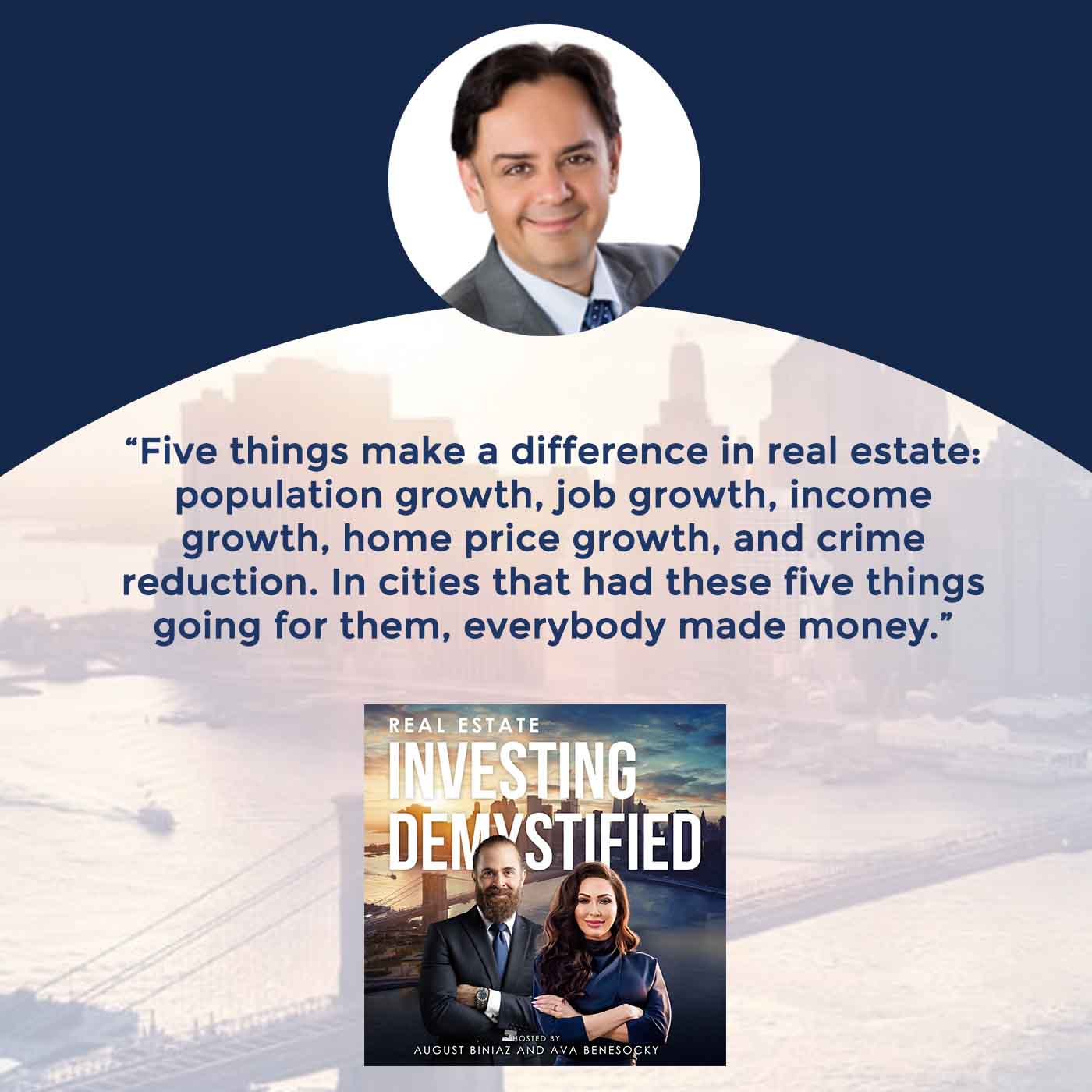Investors use different strategies when investing in real estate, depending on which strategy works best for them. In this episode, Neal Bawa shares his strategies for finding the best cities to invest in real estate. Using technology and being a geek in real estate helped him succeed in the industry. He also shares some tips about using virtual assistants to help him in his business in the real estate industry. Tune in for more tips from the Mad Scientist of Multifamily himself!
➡️ Multifamily University creates interesting and free educational content to give you an edge in multifamily real estate investing 👉 https://go.multifamilyu.com/resources
How to Find the Best Cities to Invest in Real Estate – with Neal Bawa
Join the Mad Scientist of Multifamily, Neal Bawa, as he discusses:
👉 how he was able to tap into the real estate industry using technology
👉 how being a geek helped him succeed in the real estate industry
👉 how to 10X your real estate business with the use of Virtual Assistants
👉 what are the tools that you can use to manage your Virtual Assistants
👉 how distress can help you find bigger opportunities
👉 and how you could find the best cities to invest in if you are into real estate investing
Watch the video now and feel free to drop your comments below.
Get in touch with Neal Bawa:
LinkedIn: https://www.linkedin.com/in/neal-bawa/
Website: https://grocapitus.com/
If you are interested in learning more about passively investing in multifamily and Build-to-Rent properties, click here to schedule a call with the CPI Capital Team or contact us at info@cpicapital.ca. If you like to Co-Syndicate and close on larger deal as a General Partner click here. You can read more about CPI Capital at https://www.cpicapital.ca. #avabenesocky #augustbiniaz #cpicapital
—
Watch the episode here
Listen to the podcast here
Important Links
- Neal Bawa – LinkedIn
- Census Bureau
- BLS
- Zillow
- Trulia
- R
- Udemy.com
- Udemy.com/realfocus
- MultifamilyU.com
- Grocapitus.com
- DoorDash
About Neal Bawa

Neal shares his team’s unique and cutting-edge real estate data methodologies to connect with geeky and nerdy (or just data-driven) investors who share his vision – That Data beats gut feel by a million miles. Over 10,000 real estate investors have taken his free Real Estate Data Analytics course on udemy.com and the course has over 1000 five-star reviews.
Neal speaks at dozens of real estate conferences across the country and virtually, on the Internet. Over 5,000 investors attend his multifamily webinar series each year and hundreds have attended his Magic of Multifamily boot camps. His Facebook and meetup groups have tens of thousands of investors.
Neal believes that we are at a turning point, where traditional commercial real estate will combine with Proptech and Fintech technology disruptors, and will truly reach its potential as a tradable, highly liquid asset class that will rival and eventually beat the stock market in its size and scope. He also believes that the Build-to-rent will become a much larger and more profitable part of the Multifamily asset class over the next 5 years, due to its uniquely desirable characteristics. Neal’s vision is to combine the Build-to-rent asset class with fractionalization to democratize commercial real estate.
Finding The Best Cities To Invest In Real Estate – Neal Bawa
We grew up in a lower-middle-class neighborhood in Mumbai, India. I remember that we would get chicken once a week. That was the highlight of our dinner table, the day that we had chicken because the rest of the time, you were eating staple foods. Everyone should have some phase of their life where there’s financial stress or you don’t know what the future looks like because it truly builds character in a way that’s almost impossible.
My kids are good kids. They have good hearts but they have grown up as princes. They have grown up in a huge house and have never had a need for anything. I feel like you get a warped sense of the world when that happens, and there’s no way to avoid that. I love the fact that the kitchen table, for at least 5 or 6 years when I was growing up, was bare.
I had a brother and a sister, and they were twins. They were younger than me. My dad died when they were five, so I was also dad to them. I was the elder brother. I was six years older, so I was their dad figure growing up. I had to be careful around the dinner table about what to say and what not to say. It was the other way. My mom always said, “Neal, you are set up to be an officer. You go to work, you work, you come back, you watch TV, you go to sleep. You are not set up to be the entrepreneurial kind. You are not set up to open your own business.”
Sadly enough, I believed her. What I realized is that I’ve always had strong entrepreneurial abilities, so this is one where you take the wrong thing from your parent’s beliefs. I finished my Computer Science degree and went to work for a huge company with 27,000 employees and wasted six years of my life working for them, going to work, coming back at 5:00 and watching TV, and then going to sleep. Right around the six-year mark, I felt burned out. I felt there was something wrong with my life, and I needed to take more risks.
I went to my uncle, who was moving to the US and said, “I would like to go to the US. I’ve always loved the US. I know that people like me with the skills that I have are very much in demand.” This was the late ‘90s, so this place was blowing up. Silicon Valley was desperate for engineers. He was like, “You are usually the laid-back kind. Do you want to get into something that’s going to be problematic? You do understand that it’s a big fight. You don’t just go there and get the red carpet rolled out.”
It didn’t happen. The first year here was a real struggle, despite the fact that I had the right degree and experience. My first car in the US was $450, and I’m proud to say that I sold it nine months later at $550. I made $100 on that car. It was tough. I slept on hand-me-down mattresses and in the garage of my aunt’s home in Fremont, California.
I did that piece and realized as I went through that. That wasn’t hard for me. You are going through it, roughing it out, and it was okay. It’s no big deal. I realized that I had to do more entrepreneurial stuff but then I got derailed again when a company made me an offer. I accepted their offer. Two years later, I was the VP of the company and then I got the chance to be what is known as an intrapreneur. An entrepreneur opens companies, launches companies, and works on them. An intrapreneur does the same thing inside of a company.
The CEO of the company, Paul, was a visionary. He’s a smart guy. He’s an Iranian guy that had a PhD and a Master’s degree from two different universities here. He’s genius-level smart. What he realized was that I was the kind of guy that loved launching companies but I wasn’t truly comfortable with going out there and doing it myself. I would like to do it under an umbrella. He allowed me to take crazy ideas that I had and make those ideas come to life. We launched four companies.
Three of them succeeded but one of them never grew beyond $100,000 a month in revenue, so we eventually shut it down after trying for three years, even though it was profitable. It was too distracting compared to the other businesses, and it was predominantly in the education arena, so technology education. We created all these companies and then sold them together as 1 package deal on 1 day in 2013.
From 1999 to 2013, we were building these companies together as two partners. I was a junior partner, and he was a senior partner. It was nice to be able to be an entrepreneur and still be inside a company, have a salary, and know that it was there. In hindsight, I feel like it was bad for me but while I was going through it, it still felt good to create these new companies and have the confidence that I had a W-2 salary. I feel like I didn’t stretch far enough because of that. There was a comfort zone.
Even if you have good people, you need interviewing skills. We filter people after we like them, and then we want to interview those people. Click To Tweet2013 was when we sold that company, and I had been doing real estate for a while before that. I got into real estate in reverse. We decided to build our own campus instead of renting from other people. The CEO basically threw me straight into the water there saying, “Help me build it.” He knew a lot more than I did about building and constructing these things, so the mentorship was phenomenal. I had to learn an incredible amount about real estate when building a campus from scratch.
Most people start with a minor rehab of a room. I started with a $6 million campus that had to be ready on July 4th, 2004. Otherwise, we had a $10,000 a day penalty to our landlord, General Motors was ready. There were a lot of sleeping bags going on. We were sleeping there so that we could get things done faster just to build it. I caught the real estate bug and started investing in real estate using technology. That’s what I’m known for. I’m known as The Mad Scientist, and my brand is the use of technology and different aspects of real estate and using that to 10X our business.
I will start with an anecdote of how I did it, and then I will talk about how I use it now. It’s 2009. I’m making a lot of money for my tech company but the real estate world is falling apart. Everyone was saying, “The worst thing to invest in real estate,” and I’m a data scientist. I’m a math guy. I’m a numbers guy, and I’m looking at the numbers and saying, “These numbers look so much better than they did years ago. How could you possibly say it is the worst time to invest? It seems like all the time that you guys were investing the last few years, those were bad times. This now seems like a good time.”
Nobody wanted to listen to me. My family threatened to stop talking to me if I invested in real estate. I didn’t listen to anybody. I said, “I’m going to prove you guys wrong. The math is completely against you. Instead of buying one rental home, I’m going to buy ten rental homes. I’m going to buy them in the same place but I’m going to use mathematics and I’m going to show you how I’m going to use math.” It became a stubborn thing for me. I was up against my family, who was saying, “No. Don’t invest in real estate.”
I have a clan of 42 people, not a family. What I do is I go to this Ukrainian hacker and basically say, “Could you please spider the Zillow website for me?” I’m glad that the FBI was not knocking on the front door. The next day, he comes back to the whole website and Excel spreadsheet. I sorted it and said, “What cities in the US dropped the most from peak to trough?”
2005 peaked and 2009 trough. It turns out it’s a California City. I got in my car the next day and drove 144 miles to Madera, which is near Fresno. I drove into the city and realized why the city dropped the most. Kaufman & Broad, which was one of the biggest builders in the US, built an entire brand new section of the city, and they had all these farm workers, using undocumented income to buy all these properties. By 2009, all the farm workers had left, so the entire section of the city was empty. I go to a builder and say, “How much are these worth?”
He says, “They are selling for $90,000 but the new cost of construction is $180,000 to $200,000.” I said, “If I wanted to build one now, it would cost me $200,000?” He said, “Yes.” I said, “They are brand new. Nobody has ever lived in them. They are $90,000.” He said, “There’s only one problem, Neal, and you have to solve that problem. They are no renters here at this point in time. All the renters are 22 miles away in Fresno.” I’m like, “If I could figure out how to get renters here, will I be making a lot of money?” He was like, “Yeah, you just buy as many as you could.”
I went to a bank, put ten of them under contract and said, “I need more than 30 days. I need more time,” but banks those days wanted anybody to take this stuff off their hands. I put ten of these under contract for under $1 million. I went off to Fresno the next day and said, “I wanted to buy an older property in Fresno. I don’t want to buy a bigger property. I don’t want to buy one that you built in 2006. I want something that’s 20 years old and is smaller, maybe 3 bedrooms.”
He finds me property on Summerfield Drive, and we go put that property in escrow. I went back to my Ukrainian hacker and said, “I want you to look at every rental listing website in the US. Figure out how to hack him, so instead of 1 listing, you get 50 or 100 listings.” He bombarded me with an absolute avalanche, a mountain of leads about this one property in Fresno. He was like, “I don’t know what the heck you are doing but I’m getting paid, so I’m going to shut up and do it.”
Within 3 or 4 days, all I’ve sent him as our pictures and descriptions of this one Fresno property, and I’m getting an absolute bombardment of leads. What I do is hire a person in the Philippines. I have her process these leads, and one of the things that we start telling people is, “That property, we think it’s gone and there’s a lot of interest but there are these other properties that are 22 miles away. They are brand new. Here’s a bunch of pictures and a bunch of videos.”
I paid $500 to a videographer to take these exquisite pictures, the ones that are supersaturated and look phenomenal. We are sending them videos property after property, and people are like, “I don’t want to go to Madera. I live in Fresno.” If you get a mountain of leads, only one person has to agree to check a property out of every 100 leads. In 30 days, we must have processed 3,000 or 4,000 leads. We had to do it quickly because you can’t keep the properties in contract forever. You have to pay for them.
There’s a point at which your money is going to go hard. Your deposits are going to go hard, so we had to figure out how to fill them. Thirty-five days later, I had $11,000 in cashflow. That was the first use of technology and the use of technology to hack all of these sites on the internet to get 10X the lead flow. The third one is the use of outsourcing to process those leads to get these people in, and it works. I became addicted, not to real estate but to hacking real estate with technology.
The rest of my career has been a long string of those sorts of things but this is how it all started. I didn’t use these exact things again, so I can tell you what I did next but that was it. There was this addiction, this high of saying, “I use tech to do things that 10X my revenue, my potential benefit.” Just so you know, I own all of those properties now, and the revenue from them is absolutely phenomenal because I’ve only got $50,000 left on all of these properties in terms of my principal but they are all worth $300,000 each.
It changed my life even though my big fat tech salary was still bigger, all of a sudden, I felt free. There’s always this fear with tech people that your boss is going to realize that you can hire three young guns for the same price that he’s paying you and get rid of you and hire those three guys. My boss wasn’t like that. He was great but you always have the fear in the back of your mind. You are killing yourself with a tech job. When this happened, I stopped killing myself. I started saying, “If he fires me, my lifestyle is paid for. I’m not making as much money but it’s no big deal. Life will go on.” Real estate saved my soul.
I did duplexes. I did quadplexes. I did collections of triplexes, so it was a gradual process but what happened was not buying properties. What happened was me starting to say, “What else can I hack, change or use technology in.” It was a jihad. It was a crusade and had nothing to do with buying properties. It seems like these real estate people are different from us geeks. They don’t think like us. They don’t behave like us, so maybe there’s an angle here that I can use, publish it on the web, and tell people about it. Everything had to be published on the web.
What I started doing was, I went to another guy and said, “I want to spider the Census Bureau website, the BLS website, Zillow, Trulia, and all these other websites.” I want to build a big database because I’m going to try and figure out the answer to the question, “What are the best cities in America to invest in? What are the best neighborhoods in those cities?” That question became an absolute fanatic obsession for me. I was like, “I have to be able to answer this in a quantitative way. Within that quantitative way, I have to be able to answer it in a qualitative way.”
Those are the two things that geeks like us care about. We want a new quantitative analysis but then we want a qualitative analysis. What we did was we built this database and stuck it into this statistical software called R, and we started to throw lots of different parameters in there to see, “What affected real estate investors’ profit. What are the things that if we throw into our analysis immediately point to the city?” We know the city is doing really well and people are making huge amounts of profit. If you throw into our analysis immediately, point directly to that city?
That’s what we did, and I’m trying to dumb it down here because it was a complicated algorithm. In the end, here’s the answer to all this skullduggery. Five things made a big difference. In cities that had these five things going for them, everybody made money. Even the ones that were buying foolishly made money simply because there was a huge upward momentum. All ships rose all the time. It was population growth, job growth, income growth, home price growth, and crime reduction.
Immediately the moment I say this, people are like, “You didn’t look at schools. You didn’t look at poverty levels.” The answer is I did. I stuck in the schools and ended up with the same exact list of cities. When I took the schools out, because the list was the same, and I wanted the simplest possible system, I didn’t do schools. If you want to add schools, go add them. I’m sure there’s a benefit. My focus was, “What is the smallest number of factors that gives me the same list of cities as the big list of factors?”
We did that, and then we basically switched to the neighborhoods, and we found five similar factors like poverty level and ethnic mix. Neighborhoods with an ethnic mix that was diverse were easy to rent up but neighborhoods that had one ethnic mix like all Whites, Blacks or Latinos were difficult because most of your leads got wasted. People would come, show up, and waste your time, but then they realized everyone living here is a Latino. It’s like, “I’m not Latino. I’m Chinese. I’m not going to live here.”
The most important people drive innovation and businesses forward. These people are key to the future. Click To TweetThey would waste a lot of your time, so we found that if there was an ethnic mix, which had lots of different ethnicities, you had a much higher chance of closing your marketing leads for tenants. We put it on our website, and then we realized that few people were looking at it. The people who looked at it absolutely adored it. They loved it.
They were like, “This is the best thing ever because, in ten minutes, I can look at a city that I’ve never even heard of and tell you things about it that a broker that lives in that city wouldn’t be able to tell you.” It was that powerful but there were 50 people a month taking it. We would be like, “Let’s send an email to our database.” By now, I was a micro famous person in the real estate geek vertical. It’s people that are in real estate but are geeky and like data. I was famous within that vertical, and they were all these thousands of people that knew me there.
I sent an email out to them and said, “We have this product. You’ve seen it, and it’s awesome. How do we have 10 or 50 times the people look at this?” That was a great email because the answer that came back was very straightforward. Three of the people that sent it back said, “You need to look at online education portals. Create a video course and stick it there.” I googled it, and the biggest one was Udemy.com. I’m like, “Maybe I can get 50 more people a month here.”
I spent about 20 days creating a video course that’s about 3 hours long and stick it on Udemy.com/realfocus. That was the name of the system, and it exploded. I was showing somebody how many students I have on that course. Now, there are 6,420 people taking the course. There are 600 five-star reviews, which are more reviews than all of the real estate courses on Udemy put together, and the average review is 4.8 out of 5.
It went nuts because people realized, “This guy is a geek who’s not even a real estate guy. He does something in tech and has a full-time tech job, but he loves doing all this skullduggery with numbers, this geekery, and then gives it away,” and people love that. It gave me notoriety and that Mad Scientist tag that I enjoy so much now because it urges me to do new experiments. It also gave me a big database of people. Udemy doesn’t give me the email addresses of people but they like me so much that they find their way to me.
They find their way to my MultifamilyU.com, and Grocapitus.com is our website. By this time, I was beginning to transition into real estate. I was like, “People like what I’m doing. Why shouldn’t I charge for it?” At some point, when the company was sold, I took three months off and realized that retirement is an absolutely horrible concept when you are 40 years old. You are going to kill yourself. I was depressed, so I was like, “What’s next? This technology real estate thing looks good. Let’s try that. I have already been doing some of these cool things, so I’m going to do more of it.”
It was a smooth transition because I had a big database and a big following, so I transitioned. I ended up with over $300 million worth of the real estate. There is some student housing there. We do industrial projects, we do public storage but the core is multifamily. It all seemed planned out. It was horribly disjointed, and things happened. We have 24 or 25 employees at last count, and 18 of them are full-time employees that are outsourced.
We believe that the perfect company, 2/3 of the employees are outside the US, and 1/3 are in the US. If you try to cut the US piece anymore, the company loses that flavor because Americans know what Americans want, and they work in every aspect of the company. They are all full-time. They all work 40-hour weeks and work US time. They are not allowed to work anytime except 8:00 to 5:00 US.
That portion of the business became huge, and eventually, I started writing video courses on how to 10X your business using virtual assistants. Every time I hold that as a webinar, at least 1,000 people show up, these courses are all free. They are on MultifamilyU.com. We get about 50,000 people that sign up for our various deep dive webinars.
We do webinars or all kinds of things. We do town halls, the impact of COVID on real estate, the impact of COVID on student housing, the impact of COVID on industrial real estate, and the impact of COVID on multifamily and single-family. These are deep dives, and we bring in people that are geeks, so we are pretty famous for that.

Best Cities To Invest: One of the key things people got is that they have a gut feeling that they know there’s an opportunity, but they don’t say to themselves often enough that distress creates more opportunity than boom times.
That virtual assistant piece starts out for the first twenty minutes explaining how to recruit them through a series of six demos. It goes in, looks at the actual websites, and shows you the filters. There are about twelve filters that we use because the overall quality of virtual workers is awful. It’s incredibly bad. These twelve filters allow you to get to the top 0.1%. You will watch me doing twelve different filters. Other than that, there are other filters. Even if you have good people, you need interviewing skills.
We show you how we filter people after we like them and say, “I want to interview this person,” but then we have further filters in place, including DISC tests that are free, so we give away these free DISC test links that most people don’t know about. We go on how we manage them like, “What are the best practices for managing virtual assistants? What do our reports look like?” We showed live reports and then talked about how we embed them into our life. I give people examples of how they make my life better, not just my company better. It’s extremely descriptive. There are 27 demos.
For me, I’m constantly looking at opportunities that are being created by stress. People have a gut feeling that they know this but they don’t say it to themselves often enough and that’s, “Distress creates more opportunities than boom times.” In my mind, in some ways, this event is more transformative than World War II. Not always, but in some ways, because we have an economy where millions of CEOs have to learn how to work from home. Work office habits didn’t change in World War II because no foreign soldiers stepped on US soil.
As far as our country is concerned, it was not as transformative as Europe, where the whole continent was demolished. In the last several months, we have taught the most important people that drive our innovation and our businesses forward. These people are key to our future. All of them have been forced to learn how to run businesses from home, and that is an absolutely transformational change. There’s no going back from that.
The impact of that is going to be much greater than the healthcare impact of COVID. I don’t want to minimize the healthcare impact of COVID. One hundred sixty thousand Americans are dead, so it’s a huge impact. What I’m trying to say is that if you compare a mountain to Everest, Everest is going to look better. The impact of COVID is much larger in the way it did three things. Number one, COVID has done is that it has changed the way we work forever. That is not something that we can go back to.
Even if 80% of companies go back to where they were pre-COVID, it will be ridiculously transformational because that means that 20% of companies in the US are working a different way. That changes things in a way that’s so radical that we can’t even begin to explain that to people. That was the first impact that it had. The second impact, which is tied to the first one, is that there’s going to be a portion of the US workforce that does not need to live in expensive cities anymore. They don’t need to fight traffic and live in these expensive places. They can go out and choose cities based on their interests.
If they are skiers, they will head to Provo. They will go to Idaho or Boise if they like canoeing or things like that. They are going to be heading out. They are going to go to Montana if they like the ski slopes. There are a lot of these amazing places in the US that people have never lived in because they were nervous that their bosses truly didn’t like working from home. Now that companies are making announcements and CEOs are working from home, it becomes much easier to take that step. That changes the way real estate is done in this country.
When I am in such a transformative time, I’m doing a lot. I am looking on the one side creating funds to buy distressed hotels. On the other side, I’m buying industrial because the third and final transformative effect of COVID was this. eCommerce grows five times the speed of the US economy. The US economy runs at 2% GDP growth. eCommerce runs at about 10%, so it’s already 5X the US economy. It’s the fastest vertical in the US economy.
In the last couple of months, which included all these COVID months, eCommerce grew at 77%, while the US economy grew at 0%. What has happened is that seven years of eCommerce growth has come in four months. That is also something that we can step back on. I had used DoorDash three times in the a few years before COVID.
All three times when I was in a food desert somewhere checking out a property. That doesn’t change because now all of my favorite places, I’ve got DoorDash plugged in, so now it’s, “Pick up iPad, click DoorDash, click repeat, and done.” It takes roughly ten seconds to order food now. I’m a technology guy, and I wasn’t doing it before.

Best Cities To Invest: COVID has changed the way we work forever. A portion of the US workforce does not need to live in expensive cities anymore. They can go out and choose cities based on their interests.
Imagine how many non-technology portions of the workforce were forced to do these online things. My wife’s a school teacher and has now learned Zoom and Google Classroom, something that you couldn’t hold a gun to her head to do. She had no choice. That was the only way to connect to students. The economy has become digitalized in a way that is almost radical because it was forced on us. That third change means that we need more industrial and warehousing in this country and a lot less retail.
I’m looking at building industrial warehouses throughout the United States in key markets where freeways intersect. Salt Lake City is a place where freeways intersect. The whole North Carolina to Georgia Atlanta area is where freeways intersect because there’s going to be so much shipping. I’ve always ordered a truckload of stuff from Amazon. I’ve always had trouble on Thursday morning when the trash guy comes in, my recycle bin is always full.
What I have been doing, and my neighbors know this, on Thursday morning, I wake up early and go around filling up other people’s recycle bins. Most of the time, there’s a little bit of space in other people’s bins. In the last four months, I haven’t been able to put one box in other people’s bins. I’ve seen other people roaming around on Thursday mornings, trying to find empty bins.
It’s a great time because there’s stress, there’s distress, and most of that distress is ahead of us. Little distress has happened in real estate at this point. I can’t even point to something and say, “That’s distressed.” It isn’t because it takes time. The next few months are filled with opportunities. Why wouldn’t I take advantage of it?
Whether you are interested in investing in technology-driven syndications or in, learning how to do what we do because we teach bootcamps about that or in taking our massive array of free courses, the best place to go is MultifamilyU.com. I have been on about 200 podcasts now, so the other option is that type in Neal Bawa and hit enter in Google. I have the extreme fortune and misfortune of being the only Neal Bawa on the World Wide Web. There are podcasts and conferences that I’m presenting at that have published their videos of the conference and then all kinds of geeky articles from me, so watch out. Geek alert.




